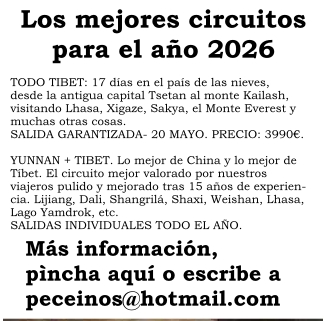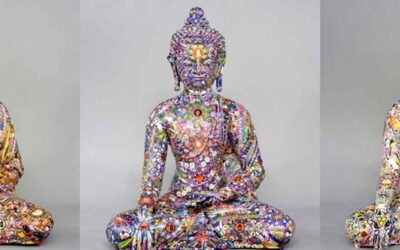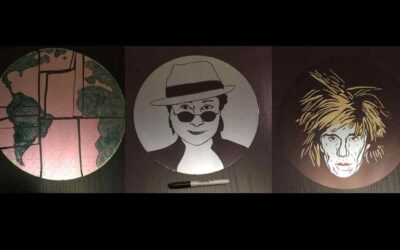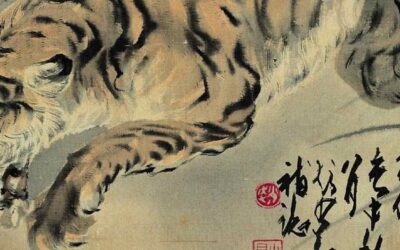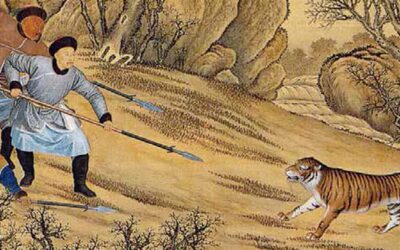On the left side was a densely wooded rocky hill. Its steep slope was carved into fantastic figures of unicorns, leogryphs and other mythological animals, and statues of gods and saints. They had been fashioned out of rock by the monks more than fifteen centuries ago. Under the hill were grottoes and caves filled with Buddhas and genii, where pilgrims were burning incense. Mantras in Sanskrit and archaic Chinese adorned the rocks, chiselled by the long departed hermits.]
Walking a little farther we came to the spacious entrance hall of a monastery which was unique in China in its grandeur, sanctity.
‘The Monastery of the Spirit’s Retreat’, softly exclaimed Chungan pointing to the three huge golden characters over the wide-open doors of the hall.
‘What a deep and secret meaning these words possess ! ‘ he continued. ‘It is a fitting name for this place, for it is difficult to conceive a better hermitage for the spirit of a man tired of the world and seeking concealment amidst the beautiful and tranquil.
Having emerged from this hall with its golden statue of Maitreya, the Lord Buddha of the Future, we stepped out into a large stone-flagged courtyard bounded by ancient trees. In front of them, on a high stone platform, flanked by two small pagodas and with a massive bronze incense burner in the middle, stood the main temple hall. its great height and immense size dwarfed all other buildings around it. The roof rose in three nobly curved tiers supported by colossal red wooden pillars.
The latticed gates of the hall were open as we came in. A mysterious semi-darkness, heavy with the odour of sandal-wood incense, pervaded the place. Right in the middle of the vast temple sat three golden Buddhas of such unbelievable majesty and of such gigantic proportions that when I saw them I was astonished. The images rested on lotus flowers which, in turn, were supported by stupendous stone pedestals. A colossal lantern, richly carved and decorated, with a perpetually-burning oil-lamp within, was suspended in front of the Trinity.
The central figure was that of the Lord Buddha himself with his royal coiffure and a sign of urna on his forehead. With the eyes turned inwards, gazing not at the world outside before him but at the world within himself; with his enigmatic smile, he sat there a true image of the man that he once was, but who had transcended all human emotions, desires, all suffering and mundane joy; who had found the lost path to Heaven and shown it to suffering mankind, and who at last had entered Nirvana and became himself a God. I gazed enchanted at the mystic statue. I felt mesmerized by the utter stillness of the temple. Clouds of incense floated in spirals towards the lofty ceiling and gently dissolved there in the golden rays of the sun coming through the narrow windows. The very silence was pregnant with the meaning of things unsaid, of prayers uttered and of petitions yet unoffered.
After we had finished our tour of the golden statues of arhats, lining the walls, and paused before an enormous image of the gentle Goddess Kwanyin, which stood against an altar piece representing the Western Paradise, we made our exit by a side door into a commodious guest hall where a young novice brought us cups of the monastery’s own tea. He smiled at Chungan and Tsungpoo, evidently recognizing them as frequent visitors. After a good rest we were ready to proceed to the next famous temple.
Goullart, Peter. Monastery of the Jade Mountain.
Peter Goullart. The monastery of Jade Mountain.
More posts on Chinese culture
El Polo en la China antigua: deporte de emperadores
El Polo en la China antigua: deporte de emperadores 1.Polo, un deporte de emperadores Cualquiera que se haya acercado al arte chino, y especialmente al arte de la dinastía Tang se habrá visto sorprendido por la multitud de imágenes de jugadoras de polo. Mujeres nobles...
Fascinante arte de Gonkar Gyatso
Fascinante arte de Gonkar Gyatso Gonkar Gyatso es uno de los artistas tibetanos contemporáneos más populares, famoso en la escena artística por sus obras únicas y que invitan a la reflexión, que a menudo mezclan elementos artísticos tradicionales tibetanos con temas...
Una entrevista con el artista interdisciplinar Daniel Hoh de Silicon Valley.
El "arte experimental" nacido de la presión - Una entrevista con el artista interdisciplinar Daniel Hoh de Silicon Valley. Berry Liu. 2018-10-08 En 2017, en una exposición de arte contemporáneo en la capital californiana, se vio a un grupo de espectadores susurrando...
El gigante, los tigres y un cebo humano
El gigante, los tigres y un cebo humano Xu Shan, un hombre de Guandong (关东), se ganaba la vida desenterrando raíces de (ginseng). Era costumbre que los excavadores de ginseng trabajaran de noche. Un día, tras una noche agotadora, Xu descansó sobre la arena. Cuando se...
El viejo cazador de tigres. Una historia de Ji Xiaolan
El viejo cazador de tigres. Una historia de Ji Xiaolan Cuando mi primo Zhonghan era magistrado del condado de Jingde, hubo un tigre que causó estragos cerca de la ciudad e hirió a varios cazadores que no lograron atraparlo. Los lugareños decían: "Sólo Tang, el hábil...
Wu Zilin y su exploración del ego y el superego en el arte
Wu Zilin y su exploración del ego y el superego en el arte La obra de Wu Zilin se basa en la práctica de la performance artística personal. Su principal enfoque creativo se centra en el ámbito de las acciones realizadas, los restos y huellas de estas acciones, así...
More posts on China ethnic groups
El Polo en la China antigua: deporte de emperadores
El Polo en la China antigua: deporte de emperadores 1.Polo, un deporte de emperadores Cualquiera que se haya acercado al arte chino, y especialmente al arte de la dinastía Tang se habrá visto sorprendido por la multitud de imágenes de jugadoras de polo. Mujeres nobles...
Fascinante arte de Gonkar Gyatso
Fascinante arte de Gonkar Gyatso Gonkar Gyatso es uno de los artistas tibetanos contemporáneos más populares, famoso en la escena artística por sus obras únicas y que invitan a la reflexión, que a menudo mezclan elementos artísticos tradicionales tibetanos con temas...
Una entrevista con el artista interdisciplinar Daniel Hoh de Silicon Valley.
El "arte experimental" nacido de la presión - Una entrevista con el artista interdisciplinar Daniel Hoh de Silicon Valley. Berry Liu. 2018-10-08 En 2017, en una exposición de arte contemporáneo en la capital californiana, se vio a un grupo de espectadores susurrando...
El gigante, los tigres y un cebo humano
El gigante, los tigres y un cebo humano Xu Shan, un hombre de Guandong (关东), se ganaba la vida desenterrando raíces de (ginseng). Era costumbre que los excavadores de ginseng trabajaran de noche. Un día, tras una noche agotadora, Xu descansó sobre la arena. Cuando se...
El viejo cazador de tigres. Una historia de Ji Xiaolan
El viejo cazador de tigres. Una historia de Ji Xiaolan Cuando mi primo Zhonghan era magistrado del condado de Jingde, hubo un tigre que causó estragos cerca de la ciudad e hirió a varios cazadores que no lograron atraparlo. Los lugareños decían: "Sólo Tang, el hábil...
Wu Zilin y su exploración del ego y el superego en el arte
Wu Zilin y su exploración del ego y el superego en el arte La obra de Wu Zilin se basa en la práctica de la performance artística personal. Su principal enfoque creativo se centra en el ámbito de las acciones realizadas, los restos y huellas de estas acciones, así...

